The Gift of South Dakota
Subscriptions to South Dakota Magazine make great gifts!
Subscribe today — 1 year (6 issues) is just $29!
Staging Comebacks
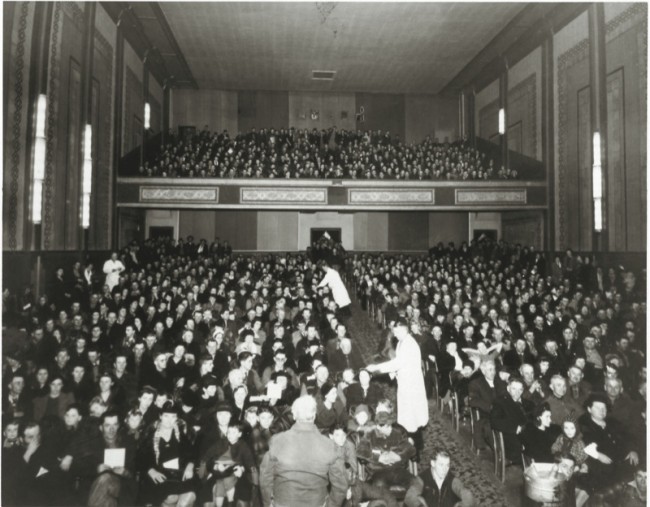 |
| Citizens gathered at Yankton's opera house in the city's early years. Photo courtesy of the Dakota Theatre. |
Editor’s Note: This story is revised from the March/April 1997 issue of South Dakota Magazine. To order a copy or to subscribe, call 800-456-5117.
The manager of the touring acting company peered out from behind the curtain. It was a cold and windy January day in Scotland, S.D., and his actors grumbled nobody would show up for their performance. The manager smiled at the sight of a full house. The happiness faded, however, when he looked out later. The crowd had taken off their heavy winter jackets and the house was, in fact, only half full.
This story notwithstanding, actors played to full houses all over South Dakota between 1880 and 1920, the golden age of opera houses. Nearly every city in South Dakota boasted one. "Opera house" was preferred to the term "theatre" because the former sounded more cultured. Opera houses showcased live theatre from either touring groups or local talent. Their multi-purpose stages also saw bands, lectures, minstrels and vaudevillian shows. Most importantly, they promoted civic pride and camaraderie in the hard times of settling a new state.
Now, a century after most opera houses were built, these buildings are regaining their former stature as integral parts of many S.D. towns. "Opera houses tell so much about who we were and who we are," said Gale Ries, former chairman of Watertown's Goss Opera House restoration committee. "We worked diligently building them long ago. Now we work hard trying to preserve them."
Opera houses ranked with general stores and schools as important buildings in early South Dakota. Like the others, the opera house provided unique services. The entire city received entertainment and culture from these theatres. Civic boosters quickly recognized the correlation between good entertainment and attracting settlers. Jeff Logan, owner of movie theaters in Mitchell, Huron and Dell Rapids, noted that, "because South Dakota was largely settled by the railroad, people arrived with ideas of culture already implanted. They wouldn't wait to have it, either." If one town didn't have a good opera house, another town down the line certainly did.
Local businessmen built most opera houses on the second and third stories of buildings with a business on the ground floor. Downtown real estate costs ran high, even then. It made sense to double the use of a large building. This way, if the theatre took a loss, the rest of the building still covered the rent.
The most popular second use for the hardwood floors of opera houses was as roller skating rinks. The sport swept the nation in the mid 1880s. Many roller skating rinks opened with the intention of switching to theatres once the fad diminished.
Most touring actors loved their craft and life on the road. Still, many balked at coming to South Dakota. It fell in an area called the Circle. One actor explained his reluctance in a poem. It went:
"I love to be an actor, and travel with a show.
But I do not crave the Circle when it's 34 below."
The troupes that did come learned to adapt. The most durable company, the M & M Show, built a lower tent. It sat underneath the wind, and avoided the common complaint of tents blowing away. They dubbed it their "South Dakota tent." Another company hauled thick particle board around the state. It reinforced the tent quite nicely until a bad hail storm blasted holes through it; they never returned.
In all fairness, it must be noted South Dakota weather, then as now, cannot overshadow South Dakota people. The actors who braved the weather returned with many fond stories of appreciative, sturdy settlers who traveled miles through the worst weather to watch performances. During the bleak winter of 1888 several communities staged "Blizzard Blockades." In northeast South Dakota, this required digging tunnels for the audience to enter the theatre.
Although weather remained the most visible aspect of South Dakota theatre, the railroad proved the most important. By 1881, a web of metal lines linked every major city east of the Missouri. West River development happened several years later. Because of the Black Hills gold rush, settlers arrived in western South Dakota long before the railroad. Almost overnight, towns sprang up from mining and supply camps.
With towns came opera houses. Before late 1890, when the first train arrived in Deadwood, actors braved unknown land and the higher cost of stagecoach travel to reach the Hills. Actors who came stayed for a while. One such actor was Jack Langrishe, the most famous name in Deadwood theatre. His acting company lasted over a decade in the town. Langrishe faced the constant challenge of varying his repertoire. In the east, troupes knew only a couple plays. The entertainment changed when the railroad carried in new actors with new plays. His company sometimes performed five different plays in one week.
The gold rush attracted a raucous crowd to the opera house. These gamblers, prospectors and outlaws did not limit their criticism to unenthusiastic applause. The most famous derogatory review came from the renowned Calamity Jane at the play "East Lynne." Charles E. Chopin, a child actor during those years, wrote of his experiences years later.
Chopin recalled that "she and 'Arkansaw Bill,' a famous stage robber, occupied front seats. Calamity dolled up for the occasion in a corduroy suit and sombrero and appeared particularly vain of her green kid gloves. Soon as she was comfortably settled, she bit a chunk of tobacco and chewed as industriously as any miner throughout the evening. She and her escort clapped in noisy appreciation until Lady Isabel eloped with Sir Francis and then Calamity showed her disapproval of the erring wife's conduct by marching down to the footlights and squirting a stream of tobacco juice over the front of Lady Isabel's pink satin evening gown."
A fight nearly broke out when Mr. Lord protested the insult to his wife. Only after Calamity Jane tossed a handful of gold coins onto the stage to pay for the damages did the actors continue the performance. Chopin recalled that thereafter, "she chewed her cud in courteous silence."
Citizens of the Hills loved theater. After Deadwood burned twice, and once after being destroyed by a flood, the opera houses were rebuilt even before houses.
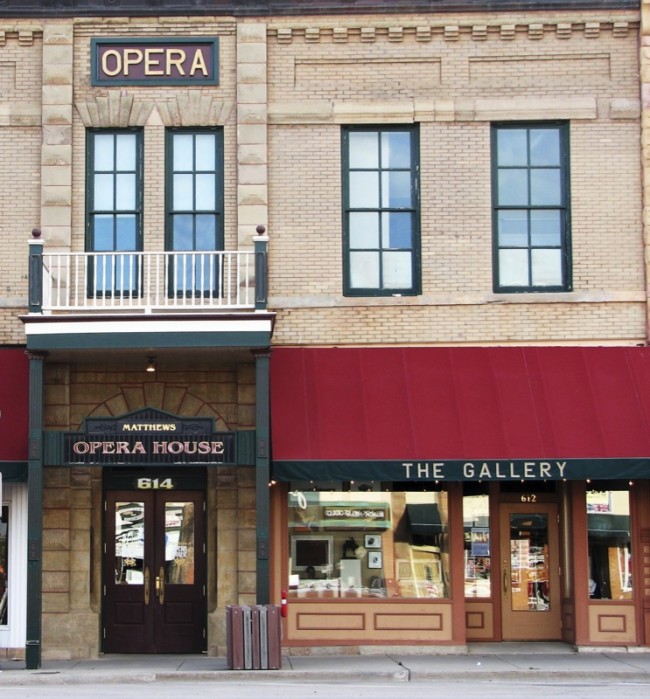 |
| Part of the Spearfish Arts Center, the Matthews Opera House is home to the local community theatre. |
Traveling companies in the east benefited from cheap and easy railroad transportation. Troupes employed more actors and more elaborate sets. Both commanded larger audiences, because both created larger spectacles. Acting companies often faced hardships arising from railroad inconsistency, however. In the rush to make the end of the line, engineers often bypassed several towns if they were not required to stop. This wreaked havoc with play bookings.
The actors wised up quickly. They started carrying around a single pig, but not for any theatrical purpose. Federal regulations forced railroads to pick up livestock. So, the manager placed the pig in full view on the platform. The engineer stopped, and the troupe made their next booking.
Temperance and moralistic dramas endured longer than any other performances. Plays like "Ten Nights in a Bar Room" and "Victims of the Bottle" championed the rising sentiments of prohibition.
The most popular of all was "Uncle Tom's Cabin." In 1902, 50 years after its premiere, no fewer than 16 troupes toured with that play alone. These "Tom shows" compensated for their lack of originality by adding unrelated tricks. Minstrels sang during intermission. Actors broke character to tell recent jokes. Real blood hounds chased down slaves. Willa Cather remarked on one show she saw in her youth that, "The barking of these dogs used to make us catch our breath!"
Unfortunately, most South Dakota opera houses have been lost. The advent of "talkies" ended the age of touring live theatre. Most changed to show movies. Many more sat dormant over the years; fire claimed some. Water damage and neglect relegated others to "condemned" status. The wrecker's ball moved in quickly in the name of progress. Still, many opera houses survived. They are seeds for a rebirth of live theatre in South Dakota. Citizens are using modern technology and old-fashioned elbow grease to restore them to their former status.
Success stories come from all over the state. Lead’s Homestake Opera House was resurrected following a fire in 1984. The Goss Opera House in Watertown sat empty for 40 years, but now hosts concerts, weddings and special events and houses Charley’s Restaurant, galleries featuring local artists, and a coffee shop. The Grand Opera House of Dell Rapids has been restored to 1888-style splendor. Community theatre troupes in Pierre, Aberdeen, Sioux Falls, Spearfish and Yankton all found homes in their local opera houses. Restoration provides a wonderful mix of historic preservation and modern utility. The building's availability alleviates booking concerns and sometimes provides a headquarters for day-to-day operations.
Just as the opera house stage held many functions, the buildings themselves possessed several connotations. What occurred within those walls reflected people's social values and personal needs. Attend a summer performance, and one could well watch a melodrama upon a serious political topic. During the winter, the same stage could host a farcical comedy to help settlers forget about the bitter cold. Their purpose bordered between economic and social, but ideology flowed throughout. They symbolized the childlike dreams of South Dakota and hopes for the future. A century later, people are discovering opera houses still speak for South Dakota as it looks forward from adolescence into adulthood, and takes with it the best things of a previous age.


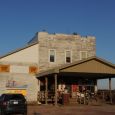
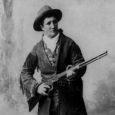
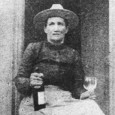





Comments